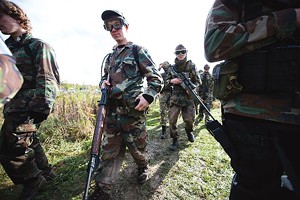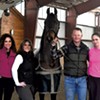Published October 17, 2012 at 7:43 a.m.
It’s 0920 — 9:20 a.m. to civilians — on a recent Saturday as a light rain falls on a muddy Charlotte pasture. Several dozen “soldiers” who bivouacked here overnight are breaking camp and moving out. Clad in full battle dress — combat boots, fatigues, helmets, goggles and tactical vests — many don’t look old enough to drive, let alone carry assault rifles. Fighting acne seems more like it.
“Safety briefing, 10 minutes!” someone shouts from a nearby staging area, an open-sided tent erected beside a vintage 1966 field ambulance and cook trailer.
The morning’s stillness is disturbed by the growl of an arriving military transport and occasional bursts of automatic gunfire. Combat hasn’t officially begun yet, but already some of the boys are firing their weapons — testing their range or venting nervous energy.
In about an hour, I will become “embedded” with some of these soldiers, who will stalk their enemy, draw fire and take casualties. The operation pits the 1990s Serbian Army against NATO forces pushing into Kosovo.
A war-games exercise for the Vermont National Guard? A military-tactics lesson for Norwich University cadets? Neither. It’s all just fun and games for the 140 participants in Operation Puma. The weekend-long military simulation, or MilSim, is being conducted by the Green Mountain Studies and Observation Group, or GMSOG.
In Charlotte, a town better known for its apple orchards and luxury homes, GMSOG (pronounced “GM Sog”) offers 130 acres of diverse terrain for staging mock firefights, historic battle reenactments and other role-playing games, complete with authentic military vehicles, aircraft and weaponry. And yes, they’re fully insured.
Begun four years ago, GMSOG bills itself as the “premier airsoft field in New England.” Airsoft, a live-action shooting game, uses replica weapons that fire biodegradable plastic BBs with compressed gas, such as CO2 cartridges.
Is this the latest incarnation of paintball, only with bigger budgets and more badass toys? Not quite, says GMSOG founder Derek Chace. The 28-year-old former airline pilot and Air National Guardsman served in Iraq in 2006. Chace, who now has a 9-to-5 gig selling vintage Land Rovers, organizes airsoft operations, or “ops,” as a recreational pastime.
“It’s just a hobby. I do it for the kids,” he says. “They build a lot of friendships here that they wouldn’t have otherwise.”
Though often compared to paintball, airsoft tries to emulate actual warfare — without all that messy business of traumatized civilians, mass devastation, PTSD and debilitating injuries.
While paintball is still more popular, airsoft is rapidly gaining followers. One reason, Chace suggests, is that it’s more eco-friendly. The BBs biodegrade quickly once exposed to water and leave behind no trace. GMSOG needs to be a clean in-and-out operation; it’s prohibited from erecting permanent structures on its property, leased from a local farmer. Evidently, zoning officials don’t object to low-flying helicopters strafing teenagers with M60 machine guns.
For Operation Puma, Chace has arranged for me to tag along with a Serb unit. While I wait, I meet Seth, 46, and his son, Ian, 15, from Braintree. Both wear German Flecktarn, or spotted camouflage, designating them as Serbs.
Like all players, the father and son brought their own weapons. Theirs are marksman rifles modified for increased range and accuracy. Though many players prefer machine guns, Seth and Ian are snipers.
How does it feel getting tagged by an airsoft BB? Like a bee sting, says Ian, who participated in an earlier GMSOG op. “You either hear it or feel it,” his dad says. “Mostly feel it.”
At 0930, NATO and Serb troops assemble, loaded for bear. To an untrained eye, many are indistinguishable from actual military. One player is dressed head to toe in a ghillie suit, looking like a dyed-green sheepdog. I hope he checks himself later for ticks.
Chace, aka Tiger — during ops, players use a radio handle — is decked out in full camo gear. He’ll command NATO, while Alex Caldwell, aka Otter, will lead the Serbs.
Chace climbs atop the ambulance and reviews the rules of engagement: Everyone must wear full-seal goggles. No shooting at wildlife, livestock, trucks, helicopters or reporters. I breathe a sigh of relief.
Also, GMSOG has a no-surrender rule, which means everyone shoots to kill. There’s no minimum engagement distance, but Chace asks players to switch their guns to semi-automatic whenever they’re within 10 feet of an enemy.
“Try to keep it civil,” he says. “You wouldn’t want to get shot in the face at 5 feet in full auto.”
When a player gets hit, he or she must display a red rag and leave the game for 10 minutes. A wounded soldier may only return after being touched by a teammate for one minute. If the player “bleeds out” — i.e., is not rescued within 10 minutes — the “dead” soldier must return to a designated area and wait there for another 10 minutes. This simulates actual battlefield losses.
“You don’t have to count it out. We all know what 10 minutes feels like,” Chace says. “It’s like one ‘Call of Duty’ match.” The players laugh at his computer-game reference.
I’m struck by how close many of these guys — and nearly all are male — are to enlistment age. That’s a change from years ago, remarks GMSOG staffer Jonathan Quiet, aka Outlaw, when airsoft enthusiasts were mostly guys in their thirties, forties and older. The cost of airsoft equipment has dropped considerably, he says, making the sport more accessible to its prime demographic. Most participants can get into it for $300, though Outlaw says, “I’ve seen guys quickly cross the $5000 mark.”
I wonder aloud how many of them will actually join the military. (If anything, Chace claims, he talks more kids out of enlisting.)
“Actually, we had a military recruiter at our last event,” Quiet says. “I don’t think he did much business.”
Once the briefing is over, the players give Chace a cheer for organizing the event. “OK,” he says, waving them off. “Now, let’s go shoot people.”
The Battle Begins 1010. I’m in an ’86 troop transport riding shotgun, which is ironic, given that I’m the only one in the truck without a gun. The bed is packed with Serbs, many of whom belong to a Vermont airsoft team called Death Jesters. (Other players have come from as far away as Maine and Connecticut.) Amped, they begin a Marine-like chant: “Whose house? OUR HOUSE! Whose house? OUR HOUSE!”
I ask the boys their strategy for the day. “Shoot to kill!” someone yells, and they all laugh. We rumble through a metal gate, past a herd of cows, across a meadow, then down a steep ravine.
We disembark along a swollen river and set off on foot, hiking across a creek and up a steep, wooded hillside until we reach a small, camouflaged outpost called Bill Hill.
Our team leader is Angus Gates, aka Stag. The 27-year-old GMSOG staffer briefs us on our mission: Capture a downed NATO pilot before he gets rescued. “Now, let’s see if we can accomplish our objective before lunch.”
While waiting for the game to start, I chew the fat with several guys in the unit. One is a jeweler in Middlebury; another works retail in a mall. They jaw on about rifle modifications, past ops and sandwiches left behind in the car.
I hear stories about a legendary airsoft team from across the lake called the Adirondack Rangers: highly disciplined former military troops (rumor has it) who have tons of cool paramilitary hardware, including night-vision goggles. “Not the cheap ones,” emphasizes one Death Jester. “The $5000 kind!”
Several guys mention Operation Blacksheep, a massive, 21-hour MilSim kill-fest that’s held annually at the 10th Mountain Division’s urban-warfare training facility at Fort Drum, N.Y. I’m told that players show up with all sorts of neat toys like “tornado grenades,” which spin around and shoot 170 BBs simultaneously “for room clearing.” Talk about fun for the whole family.
I ask the guys whether they think they’ll get killed today.
“Dude, if you go through a game and don’t get hit, you didn’t do much fighting,” says Kelsey Dobson, aka Wolf.
Airsoft got its start in the 1970s in pacifist Japan, where private firearm ownership was, and still is, illegal. At first, it was a way for Japanese gun geeks to collect authentic-looking weapons. By the early 1980s, airsoft enthusiasts were modifying their guns to shoot plastic pellets, first at targets, then at each other. By the 1990s, the sport had spread to the United States, mostly via military personnel.
At 1100 hours, a squawk on Stag’s radio informs us that Operation Puma has begun, which coincides perfectly with increasing rainfall. We move out, hiking downhill and back across the creek. Within minutes, I can’t see anything through my goggles and am tripping over logs. Call it the fog of war.
Ducking behind trees and scanning the battlefield with his M-16, Wolf takes the lead. He signals us to move ahead with a silent wave, or halts us with a raised fist.
Wolf is a high school senior whose biggest responsibility to date was working as a seasonal lifeguard in Vergennes — “Dude, you would not believe the shit that goes down at the diving board!” he declares. He has joined the Marines and ships out next August.
Up ahead, we hear several bursts of gunfire, followed by indecipherable shouting. Wolf and teammates Hunter Myers (Specs) and Quintin Lewis (Qui-Gon) advance, while I stumble behind, wary of removing my goggles and losing an eye to an errant BB.
At a meadow’s edge, Wolf returns with a Serb I don’t recognize with a red bandana on his head — our first casualty. Apparently, he surprised a NATO soldier and got shot at point-blank range. He acts surprisingly calm.
Suddenly, my three comrades pivot to the right. We’re drawing fire from downhill. Flanked! Several quick bursts of BBs whiz by, followed by single shots. Two nearby soldiers get tagged. From below, I hear a plaintive wail — “Medic!” — followed by more gunfire.
Another Serb runs back and reports a “big gun” up ahead in a bunker. A machine gun thunders, and my unit retreats, leaving me alone. Despite my orange vest and the rule about not shooting journalists, I’m not about to test NATO’s adherence to the Geneva Conventions. I haul ass back to Bill Hill.
1150. Hiking through the woods, I chance upon Ian, the 15-year-old I met earlier. Unlike some soldiers, he uses ammo judiciously. I watch as he patiently lines up a shot, then squeezes the trigger. Somewhere in the distance I hear a faint “Hit!”
Ian fires a second round. “Ow!” someone yells. In all, Ian racks up eight kills. With sniper cover, our unit advances another 30 or 40 yards. For the first time all morning, we’re gaining real estate.
As we pass enemy wounded, a NATO casualty complains that the Serbs aren’t “playing dead” for long enough. Hey, complain to the Red Cross, I think.
I check in with Stag for a big-picture update. Evidently, the Serbs failed to find the downed pilot. However, we overran NATO’s river bunkers and forced their retreat.
“So it’s very even right now,” he says. “NATO has a slight edge on us. However, the battle has turned. We’re now a real thorn in their side.”
1255. Shortly before lunch, Stag says, is when hostilities often spike — not unlike in real wars, when combatants try to gain the upper hand just before a ceasefire. Nearby, someone yells, “Five minutes!”
Stag gets word via radio that the “friendlies” we were expecting as reinforcement got decimated. He decides to send four soldiers uphill to take out a NATO post. “Go! Go! Go!” he yells.
I ask if it’s a suicide mission, sending inexperienced players to storm the hill. “Yeah, probably,” he says dismissively.
The advancing soldiers instantly draw fire. BBs whiz by as I duck behind a tree. One hits my poncho but not skin. Am I dead?
Suddenly, a collective cry goes up: “Lunch!” Several dozen soldiers, friends and foes, emerge from the trees. We hike together back to the staging area. There, Chace’s wife, Catherine, stands at a British cook trailer and dishes out her famous truffle burgers and cocoa to the boys. (During the week, she sells software.) I ask her if she ever gets into the game itself.
“No!” she says, with an incredulous look. “I don’t want to get shot!”
I notice more than a few arms and asses covered in mud — battle wounds caused by running too fast down slippery hillsides.
And, as I reflect on how to report on the morning’s firefights, I already suspect that some readers will instantly condemn airsoft itself as a different kind of slippery slope: a pastime that simultaneously glorifies and sanitizes war, even as it co-opts the name of a notoriously ugly conflict.
Granted, there’s been nary a mention this morning of ethnic cleansing, forced expulsions, mass executions or any of the countless other human-rights abuses that marked the real Kosovo.
But that’s not the point. This conflict is about boys playing army, not a history lesson. It’s as detached from actual warfare as “Grand Theft Auto” is from a driver’s ed class. Notwithstanding my own aversion to war and to America’s military-industrial complex, I know I would have eaten up this shit as a kid — and been bummed that the helicopter got rained out.
Still, by lunch I need to ship out. My own allied commander, aka my wife, has requested I redeploy to the Williston box stores on a resupply mission.
War is hell.
More By This Author
Speaking of Culture, war
-

Burlington City Council Rejects Pro-Palestine Ballot Item
Jan 23, 2024 -

Rep. Balint Reverses Course, Calls for Cease-Fire in Gaza
Nov 16, 2023 -

Protesters Disrupt Balint Fundraiser to Demand Cease-Fire in Gaza
Nov 9, 2023 -

Russian Photojournalist Dmitri Beliakov Brings His Images of War in Ukraine to Vermont
Feb 24, 2023 -

Video: Musicians Jeremiah and Annemieke McLane Move into their New Home
Mar 24, 2022 - More »
Comments
Comments are closed.
From 2014-2020, Seven Days allowed readers to comment on all stories posted on our website. While we've appreciated the suggestions and insights, right now Seven Days is prioritizing our core mission — producing high-quality, responsible local journalism — over moderating online debates between readers.
To criticize, correct or praise our reporting, please send us a letter to the editor or send us a tip. We’ll check it out and report the results.
Online comments may return when we have better tech tools for managing them. Thanks for reading.














































